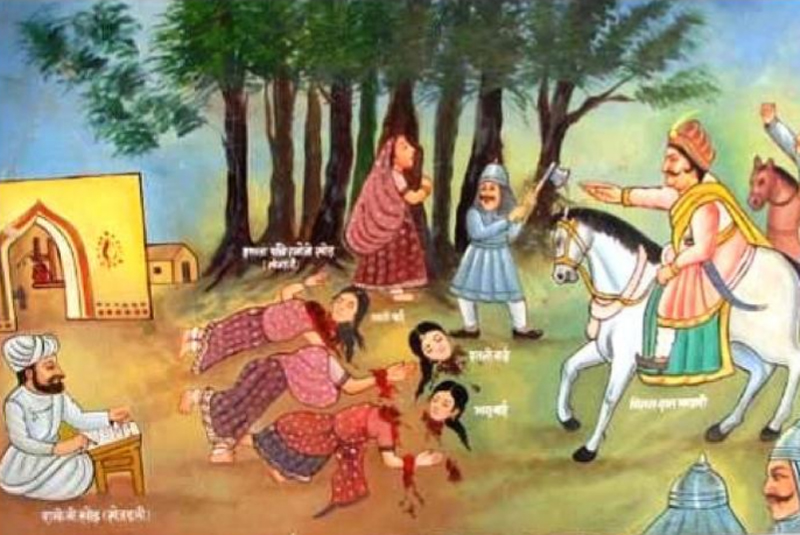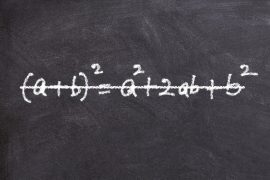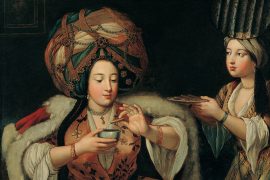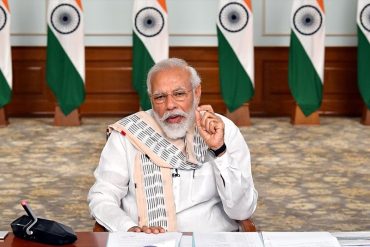The incumbent NDA government in India, spearheaded by the BJP, true to its fascist origins and ethno-nationalist ideology, have since 2014 been religiously committed to rewriting Indian history. Inspired by the worldview of the ultra-nationalist founders of the Hindu Mahasabha, which later morphed into the parent organisation of BJP—the RSS and the Sangh Parivar—history is being weaponised to further the majoritarian politics of the Modi government.
Ethnic Nationalism of Hindu supremacist idealogues V.D. Savarkar, M.S. Golwalkar, Deen Dayal Upadhyay and RSS founder K.B. Hedgewar is slowly but surely replacing the secular civic Nationalism of Mahatma Gandhi and Jawaharlal Nehru, the stalwarts of Indian Independence movement. The Orwellian dictum of realpolitik ends of Nationalism, primarily the desire for power tempered by self-deception, finds unmistakable expression in current Indian politics.
European Nationalism, post World War I, which culminated in toxic German Nationalism centred on Aryan racial supremacy and cultural superiority—and has long been eschewed by liberal democracies of the developed world since World War II—has ruefully raised its ugly head in the Indian political landscape. For Rabindra Nath Tagore – India’s illustrious Nobel laureate poet, Nationalism is a poor substitute for humanism.
The core of the Indian nationalistic variant is Hindutva (which, ostensibly, means the ‘essence of being Hindu’). It is represented by the Vedic religion of Aryans with an unscientific assertion that Aryans were the original inhabitants of Aryavarta, essentially the regions surrounding the Indo-Gangetic plain.
The high priests of Hindutva claim that Aryan culture marked the golden era of Indian civilisational glory. They claim that this thriving, cosmopolitan and liberal culture was defiled by successive foreign aggressors, starting with Muslim invaders and ending with Christian British colonialism.
Though mainstream historians—both Indian and foreign—have categorically rejected the nativistic claims of Vedic culture, it is inevitable for the BJP to anchor Hinduism that originated from Aryans to be indigenous to the land. It is the land where the epics Mahabharata and Ramayana were composed, Vedas and Upanishads were written, and its mercurial authors were the sons of the soil and not immigrants from a distant land.
But in the 1920s, with the discovery of ancient civilisational sites— the Indus Valley Civilization at Harappaand Mohenjo-Daro (currently in modern-day Pakistan)—pre-dating Aryan civilisation presented the Aryan theorists with insurmountable chronological anomalies.
Trained historians and academicians infer from archaeological evidence that the roots of the Indus Valley civilisation date back to at least 7000 BC, whereas Aryan societies mark their beginning from 2000 B.C. The general consensus among historians is that Aryans migrated from the Eurasian steppes and were predominantly nomadic pastoralists juxtaposed against the urban dwellers of the Indus Valley people. Several linguistic evidence, especially from verses in the oldest Rig Veda, suggest that Vedic Aryans and Indus Valley people didn’t share the same racial and geographical origins.
Aryans, by terminology, indicates a noble race and find its first mention in the Iranian sacred text, Zend Avesta. They weren’t idol worshippers but worshipped Agni, Indra, Varuna, and Yama as deities. Indus Valley societies, by contrast, were idol worshippers based on archaeological artefacts unearthed of gods Shiva, Sakti, and lingam (phallus). They venerated the snake, bull and some iterations of the deities Krishna and Vishnu.
The Aryans regarded Indus Valley people as inferior (Dasa or Dasyus) based on anthropological phenotypes of dark skin, snub nose, and short stature as against their wheatish complexion, tall-built, high aquiline and oval jawlines of the Aryans.
Clear racial and socio-cultural distinctions are observed in further study of Rig Vedic hymns describing and denigrating Indus Valley people as avrata (devoid of religious rites), anyavrita (infidel), ayajna (not having sacrificial offerings), krsnatvac (dark skinned) and mrdhravac (speaking an alien language).
Several other Rig Vedic hymns allude to long-drawn battles between Aryans and Anaryans (non-Aryans). Such references have convinced Indian social reformer Jyotiba Phule, polymath D.D. Kosambi and British archaeologist Mortimer Wheeler to argue an Aryan invasion hypothesis from Central Asian steppes resulting in the capitulation, banishment and decline of Indus Valley races.
However, alternative theories based on recent archaeological, linguistic, and historiographic material—by eminent historians like Romila Thapar, who denies invasion theory but endorses the view that a definitive series of migrations—have engendered the evolution of Vedic culture. The indigenous origins of the Aryan culture are categorically debunked in the light of new evidence.
There are vociferous assertions by Hindutvavadis, who maintain that Indus Valley civilisation is indeed Aryan and Hindus are their lineal descendants. Futile attempts are made frantically to push the narrative that Aryan civilisation dates back a few thousand millennia to include the Indus Valley civilisation.
Furthermore, there are no descriptions of city infrastructure in the Vedas or subsequent corpus of Vedic literature akin to the well-developed town planning of the Indus Valley tribes. There are no mentions of houses built on raised platforms, granaries, drainage systems, warehouses, and specialised clusters for craft production, quintessential of the Harappan-Mohenjo-Daro culture.
The absence of horses among discovered fossils, seals, and artefacts in Indus Valley societies—characteristic and ubiquitous of Aryan communities—further negates the claim to Aryan indigeneity. Futile attempts were made, recently by a ‘dubious’ Indian historian N.S. Rajaram and another compatriot, paleontologist Natwar Jha, to erroneously identify an animal depiction in a broken seal found in Indus valley sites to be that of a horse, plausibly to bridge the chasms between Harappan and Aryan civilisations.
A scholarly investigation on this claim—conducted by Michael Witzel, the Wales professor of Sanskrit and Ancient Studies at Harvard University and Steve Farmer, a comparative historian, confirmed the animal in the seal was that of a unicorn bull.
Genetic research has unravelled two social groups in the composition of races within the Indian subcontinent. Among the two, one ethno-linguistic group has a similar genetic-ancestral lineage—R1a1a Y chromosome haplogroup—with East Europeans.
The indigenous existence of Aryans was demystified by the discovery of a human skeleton in Rakhigarhi, dating to BCE. 2600-1900 BCE, centuries before the advent of Aryans in 1500 BCE. The DNA samples analysed failed to exhibit any ancestry with the Eurasian pastoralists, further vindicating that Aryans are not indigenous to the subcontinent.
The Hindutva defence crumbles under the weight of its inconsistencies and unverified claims, rendering their origins as foreign as malicious, war-mongering Muslim ‘aggressors’ and the cunning and deceitful Christian imperialists and missionaries. Their vicious propaganda boomerangs back on them.
Islamic ‘depravations’ to a ‘glorious’ Hindu society by the Delhi Sultanate and later Mughal dynasties through invasions, conversions, subjugation, and discriminations are recurrent themes invoked by the BJP-led Hindutva brigade. But an astute analysis of history unravels uncomfortable truths and disquieting facts.
From the raids and plunder of Mahmud of Ghazni, the Persianised Turk, to inviting Babar to invade India, the collusion and betrayal of Hindu feudal lords are seldom mentioned. M.S. Golwalkar laments writing in Organizer – the mouthpiece of the RSS – on January 4, 1950, that Mahmud of Ghazni, crossing the Khyber Pass, had befriended, through lies and deception, the local Hindu chieftains to join sides with him to defeat the Saurashtrians, falsely accusing of conspiracy to overthrow them.
When the assault on the wealthy Somnath temple occurred, the Hindus formed a vanguard for Mahmud’s army. Rana Sanga, the Hindu ruler of Mewar, is alleged to have invited Babar, along with Daulat Khan Lodi and his uncle Ala-ud-Din, to defeat Ibrahim Lodi in the First Battle of Panipat in 1526.
High-caste Hindus were instrumental in sustaining Muslim rule in India, and all Mughal emperors gave them exclusive rewards and prerogatives. Aurobindo Ghose, one of the doyens of the Indian nationalist movement, narrates that upper-caste Hindus adorned lynchpin roles in the Mughal kingdoms and were bestowed with land rights to large swathes of Northern India, especially for the Rajputs, with the possible exclusion of western Punjab province.
Maasir-ul-Umra, the authentic record of bureaucratic officials in Mughal kingdoms from 1556 to 1780, shows 100 Hindus employed as high-ranking officials out of the 367, most of them being Rajputs from Rajputana, Bundelkhand and Maharashtra. Brahmins were the second largest beneficiaries among Hindus in Mughal administrative positions. Mughal emperors after Akbar were all born of Hindu mothers.
Temple desecrations, destructions and forced conversions by Islamist rulers are two elements of Hindutva bigotry against Muslim rulers that are now extended to lawful Muslim citizens of India. Both require scrutiny and evidence-based conclusions.
Temples in ancient India were symbols of the sovereignty of kings; the presiding deity legitimised their kingship, drawing parallels to the ‘Divine Right of Kings‘ political doctrine of medieval European Christendom.
Richard. H. Davis, professor of Religion and Asian Studies at Bard College, in his essay, Indian Art Objects as Loot, elucidates this divine-royal metaphysical nexus. Therefore, destroying and desecrating temples and idols was a means to delegitimise the defeated king from the most visible manifestation of his former legitimacy of kingship.
The temple complexes in the early medieval period were essentially political institutions. Richard. M. Eaton, professor of South Asian Studies at the University of Arizona, has extensively researched temple desecrations using contemporary epigraphic and literary sources spanning five centuries of Mughal rule (1192-1729). Verified historical sources confirm eighty instances of temple desecrations beyond ambiguity, which is abysmally lower than the propagated canard of 60,000 by Hindutva leaders.
It should be noted that temple desecration was not only the political agenda of Muslim rulers but also that of Hindu kings to ascertain their suzerainty over the defeated foes. In BCE 642, the Pallava ruler Narasimhavarman I vanquished the Chalukyas and took the idol of the presiding deity Ganesha to his kingdom in Tamilnadu. It later gained fame as Vatapi Ganapati.
In BCE 950, the Chandella ruler Yashovarman dedicated a temple to Lakshman at Khajuraho to house the deity Vishnu Vaikunth, made of gold. The idol changed hands through a series of conquests, each time when a king in possession was capitulated and finally rested with Yashovarman’s annexation of Pratihara’s kingdom.
Chola King Rajendra I, after defeating several North Indian kings in successive battles, plundered the wealth of their temples and made the captives transport those to his kingdom down south. The exploits of another Chola emperor, Rajadhiraja, in 1045 BCE, obliterating the defeating Chalukya ruler’s capital, Kalyani and looting its wealth, and the early tenth-century Rashtrakuta king destroying the temple of Kalapriya holds ample testimony of this practice in the pre-Islamic era.
The Pallavas of Kancheepuram, Palas of Bengal, Rashtrakutas of Manyakheta, Kalingas of Odisha, Karkotas of Kashmir, and Tuluvas of Vijayanagara all engaged in temple desecrations, loot, and destruction of the vanquished kingdoms.
In the complete works of Swami Vivekananda, vol. 3, p.264, he mentions that the temple at Jagannath was a Buddhist stupa, which was annexed and ‘Hinduised’ later. According to the historian D.N. Jha, King Pushyamitra Sunga was the ‘torturer in chief’ of Buddhism. The ‘Theory of Iconoclasm,’ practised by ‘Islamic invaders,’ is proved to be nothing but indoctrination by the bigoted Hindutva proponents.
When the British conducted the first Census in 1871-’72, the demographic composition of Hindus, including the Sikhs, was 140 million, representing 73.5 per cent of the total population, 40.75 Muslims at 21.5 per cent and 5 per cent of Buddhists, Jains, Christians, Jews, Parsis, Brahmoes etc. combined.
The density of the Muslim population in undivided India was concentrated in Pakistan, Kashmir, Bangladesh, and Malabar regions that adorn the peripheries of the subcontinent. In the heartland of Muslim rule covering Delhi, Bihar, UP and East Punjab, the Muslim population never crossed 16 per cent.
According to the 2011 Census, Hindus constitute 79.8 per cent of the population, and Muslims constitute 14.23 per cent. Is this data proof of widespread proselytisation or accommodation of other religious faiths during the Mughal dynasty?
The most vilified, derided, and despotic Mughal emperor, Aurangzeb, had persecuted not only Hindus and re-introduced the Jizya Tax but also Shias, Sufis and his father and brothers.
Nonetheless, contemporary records reveal that he patronised Hindu and Jain temples of worship. He earmarked more grants to Hindu temples, Mutts and Brahmins than his illustrious predecessor, Akbar.
De-colonialism is another favourite theme of the Hindutvadis. They castigate the British and Christian missionaries for entrenching the divisive and inhuman caste system in India. Anything progressive, secular, and liberal is immediately condemned as a colonial mindset.
The British policy of divide and rule by partitioning the mind-space of Indians is religiously followed by the Modi government as an inherited legacy. Hindu-Muslim communal conflict was a phenomenon that had its beginnings with British rule and was unheard of during the Mughal period.
Positioning Mughal rule in India as an era of subjugation, discrimination, and oppression was the handiwork of British historians, especially Sir Henry. M. Eliot’s gargantuan eight-volume ‘History of India, As Told By Its Historians.’ It is often classified as a deviant narrative of the Mughal empire, delegitimising it by erroneously inserting genocides, desecrations, forcible conversions, proscriptions and prohibitions, murders, and banishments to suit the British realpolitik agenda and to legitimise their colonial occupation with pretentious advantages to India.
Such commissions and omissions resurface in high-school history textbooks in India post-2014. They promote a Hindu-first version of Indian history. Textbooks were revised to partially exclude content on Mughals, and references to Mahatma Gandhi’s vehement opposition to Hindu Nationalism were removed along with the Gujarat riots in 2002, under Modi’s watch as Chief Minister.
The Taj Mahal, one of the seven wonders of the world, is removed from tourist booklets; the UP government is unabashedly promoting the magnificent monument as a defunct Shiva temple! The expert committee on school curriculum development has no qualms about including mythological stories of Ramayana, Mahabharata, and other fairy tales and legends as historical truths.
Also missing is gender discrimination and violence against women, which creates a distorted view of the reality of India as an egalitarian culture from time immemorial. The Hindutva bandwagon clamours for justice against the imagined enemies of the Mughals.
These spin-doctors of Hindu resurgence who cry victimisation at the hands of the foreign aggressors sanctimoniously ignore the inhuman victimisation meted out to the untouchables and backward castes of the Hindu populace for over two millennia.
India has a long civilisational history, and its current society evolved through the amalgamation and assimilation of various cultures brought about by migrations, commingling and inculturation from antiquity. Rewriting Indian history to suit a slanted political agenda of garnering majoritarian votes jeopardises communal harmony and social cohesion of future generations, thereby committing moral turpitude.
Hindus, Muslims, Sikhs, Parsis, Christians and all who have called India their homeland for generations are inalienably part of its history and heritage. India never had an anachronistic, doctored, and monolithic past, and so it should be her present and future.
In the contemporary political scenario, history is being charge-sheeted, the accused are mediaeval actors, and the trial is predominantly on a 500-year rule in its 5000-year-old history.
The premeditated judgment is passed against lawful 21st-century Indian citizens, bound by constitutional law that guarantees equality and justice. Winston Churchill warned of the perils of such an ignoble endeavour in his timeless words:
If we open a quarrel between the past and the present, we shall find that we have lost the future.
-30-
Copyright©Madras Courier, All Rights Reserved. You may share using our article tools. Please don't cut articles from madrascourier.com and redistribute by email, post to the web, mobile phone or social media.Please send in your feed back and comments to editor@madrascourier.com











